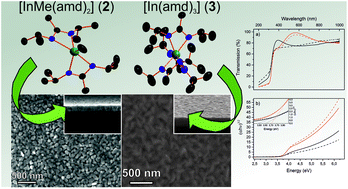New amidinate complexes of indium(iii): promising CVD precursors for transparent and conductive In2O3 thin films†
Abstract
For the first time, synthesis of two new amidinate-ligand comprising heteroleptic indium complexes, namely [InCl(amd)2] (1) and [InMe(amd)2] (2), via salt-metathesis and their detailed characterization is reported. For comparison, the earlier reported homoleptic tris-amidinate [In(amd)3] (3) was also synthesized and analyzed in detail especially with respect to the thermal properties and molecular crystal structure analysis which are reported here for the first time. From nuclear magnetic resonance spectroscopy (NMR) and single-crystal X-ray diffraction (XRD), all three compounds were found to be monomeric with C2 (compound 1 and 2) and C3 symmetry (compound 3). Both halide-free compounds 2 and 3 were evaluated regarding their thermal properties using temperature-dependent 1H-NMR, thermogravimetric analysis (TGA) and iso-TGA, revealing suitable volatility and thermal stability for their application as potential precursors for chemical vapor phase thin film deposition methods. Indeed, metalorganic chemical vapor deposition (MOCVD) experiments over a broad temperature range (400 °C–700 °C) revealed the suitability of these two compounds to fabricate In2O3 thin films in the presence of oxygen on Si, thermally grown SiO2 and fused silica substrates. The as-deposited thin films were characterized in terms of their crystallinity via X-ray diffraction (XRD), morphology by scanning electron microscopy (SEM) and composition through complementary techniques such as Rutherford-backscattering spectrometry (RBS) in combination with nuclear reaction analysis (NRA) and X-ray photoelectron spectroscopy (XPS). From UV/Vis spectroscopy, the deposited In2O3 thin films on fused silica substrates were found to be highly transparent (T > 95% at 560 nm, compound 3). In addition, Hall measurements revealed high charge carrier densities of 1.8 × 1020 cm−3 (2) and 6.5 × 1019 cm−3 (3) with a Hall-mobility of 48 cm2 V−1 s−1 (2) and 74 cm2 V−1 s−1 (3) for the respective thin films, rendering the obtained thin films applicable as a transparent conducting oxide that could be suitable for optoelectronic applications.



 Please wait while we load your content...
Please wait while we load your content...